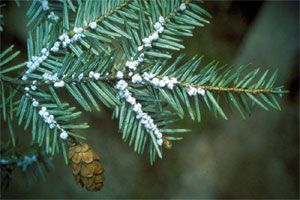If there’s a silver lining to the endless cold and snow of this winter, it’s that struggling forests are getting a reprieve from the toll of invasive insects.
For decades, winters have been too warm to kill off insects, creating a never-ending population boom that’s been chewing up trees coast to coast.
This year, forests got a reprieve as it finally became cold enough to kill most of the insects. For example, emerald ash borer populations are down 80% in the upper Midwest, according to the US Forest Service. They have been decimating ash trees across their range.
90% of the hemlock woolly adelgid are dead, which have been killing off hemlock trees further and further north in the East; corn earworm, found in nearly every state; and cottony cushion scale that destroys citrus crops. Even the gypsy moth population could be temporarily controlled – it works on some 80 species of trees and has been spreading west from the Northeast.
hemlock woolly adelgid:

They will be back, however, when the weather warms but not in such big numbers … at least for awhile.
One holdout seems to be the pine beetle which, since the late 1990s, has devastated 6.6 million acres of lodgepole pine forests in Colorado. Even temperatures of minus 20 degrees aren’t cold enough to kill it. By the time cold arrived in mid-December, the insects were dormant – only prolonged minus 30 degree temperatures could get them.
If the deep freeze occurred in October or November, they would be dead, Dave Leatherman, a retired Colorado State Forest Service entomologist, told the Denver Post.
Another holdout are ticks, and it seems to be for the same reason – winters arriving later. Even brutal cold in New Hampshire hasn’t been enough to help besieged moose. Last summer, scientists were dismayed when they found the moose population plummeting because of ticks. Hundreds of thousands of ticks can be on a single moose, killing calves and weakening adults.
This winter was cold, but it arrived too late in New Hampshire to kill the ticks.
Over the last 30 years, tree deaths in Western old-growth forests, such as Yosemite, have more than doubled because of warmer weather.

